|
IV. THE CENTRAL DISTRICT, Final Section.
On Washington, corner of Boylston Street, lately stood the
Boylston
Market, a plain brick structure. This was built in 1809, and at that
time its site was on the outer margin of the town. It was designed by
Bulfinch, dedicated with a speech from John Quincy Adams, and presented
with a clock by Boylston. A fine stone structure, erected in 1888 for
the Continental Clothing House, now occupies the site of the old
Market. The building opposite, near the corner of Essex Street, bears a
brownstone bas-relief commemorating the famous elm which once stood on
that site, of which Lafayette said: “The world should never
forget the spot where once stood LIBERTY TREE.” Here the Sons of
Liberty used to assemble, before the Revolution, to organize resistance
to British oppression. On Tremont Street, between Boylston and Mason
streets, is the new and highly decorated Tremont Theatre, which has
been built with many extensions in the building once occupied by Codman
Hall.
On Boylston Street, midway between Washington and Tremont Streets, is
the building of the Boston Young Men’s Christian Union. This
organization was instituted in 1851 and incorporated in 1852. Its
building is a handsome structure with its clock-tower above the Gothic
front of Ohio sandstone. The building contains parlors,
reception-rooms, class and reading-rooms, apartments for games, for
correspondence, and President and Directors’ room, besides a
gymnasium and a public hail. There is also a library of 7,000 volumes;
and the collection of curiosities includes, among many other things,
475 birds whose habitat is in Massachusetts. The Union Hall seats 520
persons, and has a stage and side-rooms suitable for theatricals, for
which it is often hired. Norcross Hall (which also may be hired) seats
275 persons. During the spring and summer months of 1883 the building
was considerably enlarged by the addition of a wing, so that the ground
area now occupied is 11,000 square feet. By this addition the library
and reading-room are considerably Young Menu Christian Union. enlarged,
the latter becoming the largest reading-room in the city. The area of
the gymnasium is also enlarged. Many new appliances have, moreover been
added to the latter, and it is now one of the finest and best equipped
in the city. The benevolent work of the Union includes an
employment-bureau, a boarding-house committee; committees for
receptions, Christmas and New Year’s festivals to needy and
worthy children, Thanksgiving dinners for members unable to be with
kindred, clothing for poor children, “the country week”
(vacations in the country for poor children), and rides for invalids;
and a committee on churches (of all denominations). There are also
ladies’ committees associated in these and other charitable and
kindly labors. Lectures, readings, dramatical and musical
entertainments, and practical talks on matters of science, art,
history, literature, and political economy are given during the winter
season. Classes are held in a great variety of branches, and also
social meetings and suburban excursions for information and pleasure.
The Union is free from debt.
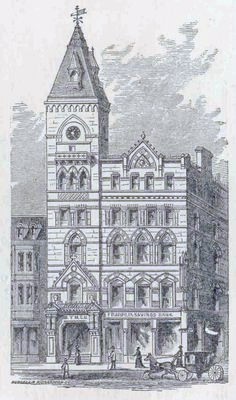
Young Men’s Christian Union. The Hotel Boylston, on the corner of Boylston and Tremont
Streets,
has lately been remodelled for business purposes, and is no longer an
apartment hotel. It belongs to the estate of the late Hon. Charles
Francis Adams. Its architecture is pleasing and tasteful, and its
location gives it a great advantage over some other fine buildings that
must be viewed from the opposite side of a narrow street. Steinert
Hall, an attractive and favorite hall for chamber concerts, is in the
second story.
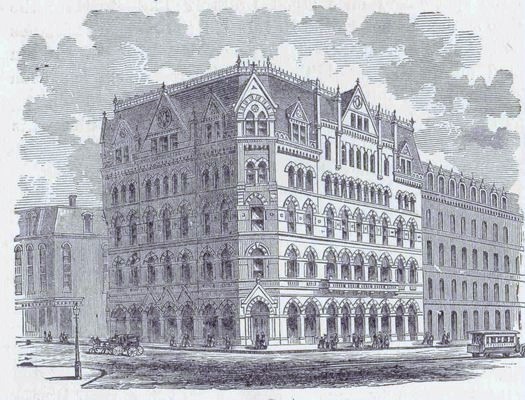
Hotel Boylston. The Masonic Temple stands on the opposite corner of Tremont
and
Boylston Streets. The headquarters of the order for many years was the
building on the corner of Tremont Street and Temple Place, remodelled
for business purposes in 1885. Subsequently the several organizations,
or a large number of them, were gathered in the building adjoining the
Winthrop House, at the corner of Tremont and Boylston Streets. Both the
hotel and the halls were destroyed by fire on the night of April 7,
1864. It was then determined to build a temple worthy of the order on
the same site. The corner-stone was laid with imposing ceremonies on
the 14th of October of the same year, and the temple was dedicated on
the Freemasons’ anniversary, St. John’s Day, June 24, 1867.
On the latter occasion President Johnson was present, having accepted
an invitation to participate in the ceremonies, which drew together
delegations of brethren of the order from all parts of Massachusetts
and New England. The building is of fine granite. It has a front of
eighty-five feet on Tremont Street, and its height is ninety feet,
though one of the octagonal towers rises to the height of one hundred
and twenty-one feet. It has seven stories above the basement, of which
only the street and basement floors are occupied for other than masonic
purposes. There are three large halls for meetings, on the second,
fourth, and sixth floors, finished respectively in the Corinthian,
Egyptian, and Gothic styles. On the intermediate floors are ante-rooms,
small halls, and offices; while in the seventh story are three large
banqueting-halls.

Masonic Temple. On Tremont Street, between Boylston and West, is a marble
structure
of architectural beauty, which has added not a little to the
attractiveness of Tremont Street. It is occupied by the Mason &
Hamlin Organ and Piano Company for their warerooms. In this building is
the Boston Conservatory of Music, an admirable institution, directed by
Julius Eichberg, one of the foremost of Boston musicians. In the
building adjoining is the Chickering Hall, in which some of the finest
chamber concerts are given during the musical season.
The retail trade of the Central District is chiefly transacted in that
section bounded on the east by Washington Street, the greater part of
the territory between Washington Street and the wharves being given up
to wholesale business. The ladies’ quarter has its centre in the
neighborhood of Washington and Winter Streets. On any pleasant day the
sidewalks and stores in the immediate vicinity of that corner are
crowded with ladies engaged in the delightful occupation of
“shopping,” and the streets are lined with their carriages.
On the east side of Washington Street, occupying the spacious lot
between Central Court and Avon Street, is the building occupied by
Jordan, Marsh, & Co., as a retail dry-goods store. It has a fine
front of dark freestone, five stories high. At first the building
covered only a portion of the lot, and the firm occupied the street
floor and basement, the second floor being used as a warerooms by
Chickering & Sons, with a beautiful hall at the rear known as
Chickering’s Hall, while the upper floors were arranged into
suites of lodging-rooms mostly occupied by artists and other
professional people. in course of time the business of the firm spread
over the entire building, and large additions to the structure,
extending it to Avon and Summer Streets, were made. The several floors
are reached by elegant passenger elevators, and there are an abundance
of conveniences for shoppers.
The dry-goods store of H. H. White & Co. is nearly opposite the
Boston Theatre, and one of the chief ornaments of Washington Street,
with its palatial front and the skillfully arranged displays in the
windows. This establishment is perhaps the largest in New England. It
now occupies the entire building extending through to the Harrison
Avenue extension; and upon the corner of Bedford Street and Harrison
Avenue is a fine new entrance of impressive appearance. The first and
second stories of the great building are given to retail trade; the
third is reserved for the wholesale trade; and on the fourth hundreds
of women are engaged in making ladies’ garments. The structure
occupied by this firm is a fine specimen of the commercial architecture
of Boston. Their richly furnished reception room is well worth visiting.
Another great dry-goods establishment in this vicinity is that of C. F.
Hovey & Co., occupying a large and massive granite building on
Summer Street. There are several other great structures devoted to this
business in Winter Street. One of the handsomest commercial buildings
in the city is on the west side of Washington Street, near Winter
Street, — a lofty edifice of light-colored stone, rich in fine
carvings.
On Washington Street, east side, north of Summer Street, is the marble
structure occupied by Macullar, Parker & Co., for their great
wholesale and retail clothing manufactory and sales-room. Its fine
front is very striking, and its internal arrangements are as perfect as
its architecture. It is one of the largest buildings in the country
wholly devoted to the business of clothing manufacture. It fronts
forty-six feet on Washington Street, and extends back to Hawley Street
two hundred and twenty-five feet. This building is nearly an exact copy
of that on the same spot which was destroyed in the great fire.
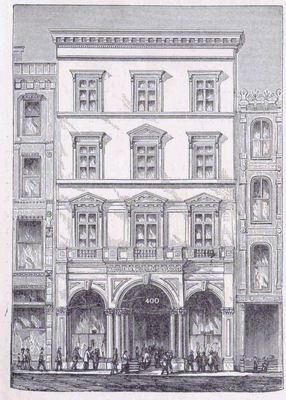
Macullar, Parker & Co.’s Building. Boston owes to the fire of 1872 a group of buildings which are
among
the most stately and costly of any in the city. These have been erected
by life insurance companies for the most part in the immediate
neighborhood of the new Post-Office. The magnificent marble building of
the Mutual Life Insurance Company of New York is one of the most
beautiful as well as one of the most expensive of them. It fronts
sixty-one feet on Milk and one hundred and twenty-seven feet on Pearl
Street, and is constructed of fine white marble from the Tuckahoe
quarry. It is intended to be fire-proof, t h e window-sashes of iron
being set in marble frames, while all the floors a reconstructed wholly
of incombustible material. The architecture of the exterior is the
modern French detail, adorned with elaborate carvings, and crowned by a
lofty Mansard rod The chief feature is a beautiful marble tower, rising
from the centre of the main front to a height of 130 feet, and
terminating in a graceful spire. On the upper part of the tower is a
large clock; and an alarm-bell hangs inside. Near the top of the spire
is an observatory, surrounded by a brass railing.
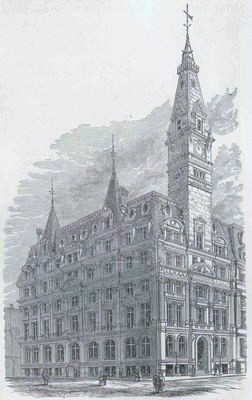
Building of the Mutual Life Insurance Company of New York. The handsome new building of the New England Mutual Life
Insurance
Company stands on the corner of Milk and Congress streets, with a
frontage of fifty feet on the former and one hundred and eighty-one
feet on the latter street, arid is one of the chief ornaments of
Post-Office Square. It is built of white Con cord granite, except the
basement, which is of Quincy granite, in the Renaissance style of
architecture. The building is admirably constructed. A fine marble
staircase runs from the first to the sixth story. The building is
furnished with numerous vaults and safes, the basement alone having no
less than ten safes for the accommodation of the Boston Safe Deposit
Company. The New England Mutual Life occupies the second story of its
building.
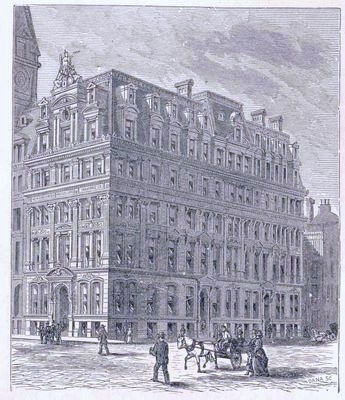
Building of the New England Mutual Life Insurance Company. The Cathedral Building is a handsome iron structure on
Winthrop
Square, occupying the site of the ancient Cathedral of the Holy Cross,
the scene of the labors of Bishop Cheverus, who was afterwards
Cardinal-Archbishop of Bordeaux. It was a part of the estate of the
late Isaac Rich, and its revenues formed a portion of the endowment of
Boston University, until it passed to the University to which it now
belongs.
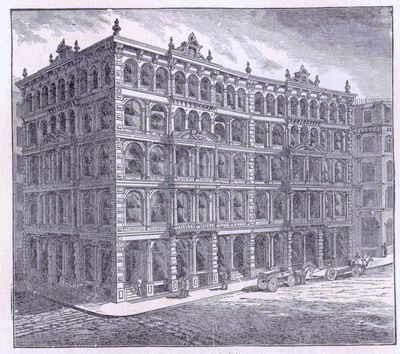
The Cathedral Building.
At the south end of Winthrop Square is the Beebe-Weld Building, a large
and imposing granite structure.
The Equitable Building is a lofty and massive structure on
Devonshire, corner of Milk streets, opposite the Milk Street end of the
Post-Office, and as near as possible to the centre of commercial
Boston. It is owned by the Equitable Life Assurance Society, and was
built in 1873, at a cost of $1,100,000. The walls are of Quincy and
Hallowell granite, with ponderous brick backing, the floors being of
impervious artificial stone on brick arches, the partitions of brick
and the roof of iron amid slate. There are nine stories above the
basement, which are reached by three elevators and broad stairways of
marble. The basements are occupied by the massive fire and
burglar-proof safe deposit vaults of the Security Safe Deposit Co.
Above these are banks, railroad and mining corporations, and other
offices, occupying the various stories, which are divided by heavy
fire-proof partitions, with artificial stone floors laid on iron
girders and arches. The roof, easily reached by elevator, commands a
fine view of the city and harbor. It was formerly occupied by the
United States Signal Service, with its wind-vane, anemometer, and other
scientific appliances, which now uses the great roof of the Post-Office
opposite. The officers of this department are continually making
observations here. The cautionary signals to the vessels about to sail
are displayed here, and warn of approaching storms. At another point on
the roof is the great time-ball, which falls daily at precisely noon,
being connected by telegraph with the Observatory of Harvard University.
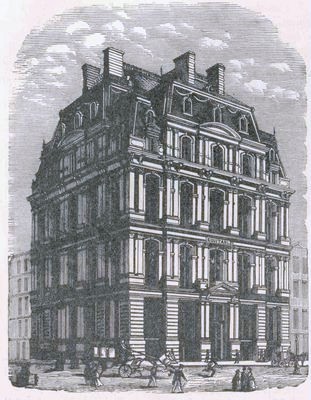
Equitable Building. The site of Franklin Street was a miry swamp, and was drained
a
hundred years ago by Joseph Barrell, a wealthy trader on the northwest
coast of America. The reclaimed site of Franklin Street became Mr.
Barrell’s garden and fish-pond, his mansion being on Summer
Street. In 1793 Bulfinch and Scollay built here the first block of
buildings in Boston, a line of sixteen dwellings, called the Tontine
Crescent, in front of which was a grass-plot three hundred feet long,
containing a monumental urn to the memory of Benjamin Franklin. Ten
years later the Cathedral was erected, farther down the street, and was
a great structure in Ionic architecture, designed by Bulfinch. In 1860
the Cathedral had become insecure, and the ground on which it stood was
sold for enough to aid greatly in the construction of the enormous and
costly Cathedral at the South End. The old Cathedral fronted on
Devonshire Street, which was then known as Pudding Lane, a narrow and
winding alley running by the old Boston Theatre. Several of the ancient
churches were also in this vicinity, and among them was the Federal
Street Church, which rose in 1744, near the corner of Federal and
Franklin streets, and was conducted by Belknap, Channing, and Gannett.
At the corner of Federal and Milk streets once stood the stately house
from which Governor Shirley was buried, in 1771, and which was
afterwards the home of the able and witty Robert Treat Paine, father
and son.
One of the most extensive business blocks in the burned-over district
is that erected by the late Gardner Brewer, Esq., on Devonshire,
Franklin, and Federal streets. it is of Nova Scotia free-stone, and is
in general highly satisfactory from an architectural point of view,
though not so rich in ornamentation as others.
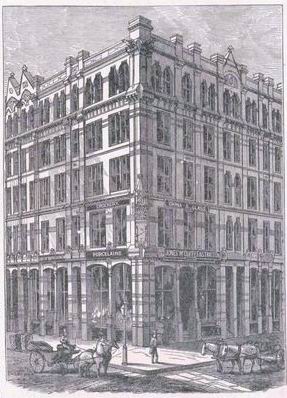
The Brewer Building. Among the other large buildings whereof the architecture or
the
material are worthy the attention of strangers are all of those in
Winthrop Square, which are almost uniformly rich in design and handsome
in form; two fine buildings erected by the Sears estate, one at the
corner of Summer and Chauncy streets, and the other at the corner of
Franklin and Devonshire; the store at the southern corner of Washington
and Summer streets. On Thanksgiving day, 1889, a most disastrous fire
swept Bedford Street from Columbia to Chauncy streets, completely
destroying the superb Ames building, designed by Richardson, the New
England Shoe and Leather Exchange, and many other flue structures. The
damage was estimated at $6,000,000.
Within the limits of this district are, as we have said, all the daily
newspaper offices, and many of those of the weeklies. The section of
Washington Street, between State, and just south of Milk Street has
come of late years to be called “Newspaper Row.”
The office of the Transcript, the oldest of the evening newspapers, and
next to the Advertiser the oldest daily in the city, is the farthest
south. It is a literary paper, and noted for the excellence of it a
miscellaneous reading matter. It has been long the favorite afternoon
paper of Boston and vicinity, and its present quarto form is in marked
contrast to its diminutive beginning. The Transcript was first
published in July, 1830, and until the spring of 1875 the senior
partner of the original firm was still the head of the house. The
experiment was for some time one of doubtful success, but no paper in
Boston is now more firmly established. During the entire period of its
publication it has had but six editors-in-chief. The late Mr. Daniel
Haskell, the fourth of the line, held the position for nearly a quarter
of a century. The Transcript has always been a pleasant, chatty,
tea-table paper, full of fresh news, literary gossip, and choice
extracts from whatever in any branch of literature is new and
entertaining. The large and attractive building in which it is now
located is on the corner of Washington and Milk Streets. It has several
special features that make it a particularly cosy and convenient
office. The Transcript was unfortunate in the fire of 1872, for it was
driven suddenly out of an office almost new, and gunpowder used in the
cellar of the adjoining building destroyed its presses, types, and
other material stored in its fire-proof, but not gunpowder-proof
basement. The present building is much larger and finer than the one
destroyed. Edward H. Clement is the present editor-in-chief of the
Transcript.
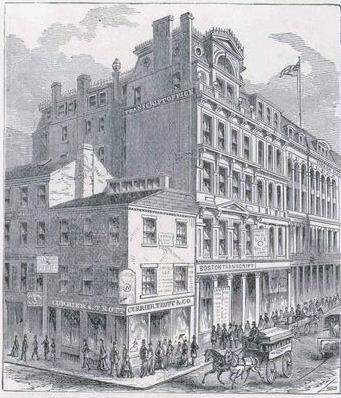
Washington Street: Transcript Office before the Fire. A few steps from Washington Street, on Milk Street, is the
office of
the Boston Post. The Post building occupies the spot which tradition
declares to have been the birthplace of Benjamin Franklin. The first
number of the Post was issued on the 9th of November, 1831, by Charles
G. Greene. In that first number the editor promised “to exclude
from its columns everything of a vindictive or bitter character;”
and although he announced his intention to discuss public questions
freely and fearlessly, he agreed to do so “in a manner that, if
it failed to convince, should not offend.” The promise has been
faithfully kept. The Post has frequently maintained the unpopular side
in political controversies, but it has always done so in such a manner
as to make almost as many friends among those it opposed as among
persons of its own political faith. It has also always maintained a
reputation for liveliness and cheerful humor that has been well
deserved. In May, 1885, it passed by purchase into the hands of
entirely new owners and under an entirely new management, and it has
since been conducted as an independent paper. It devotes a large
portion of its space to financial, commercial, and marine news, and
addresses itself to business and Boston Post Building. literary men.
The Post was first published in its present quarters on the morning of
August 31, 1874. The street floor is used for a counting-room, the
press and mailing rooms are in the basement, and on the upper floors
are the editorial and composition rooms. The Post is a quarto, and is
sold at two cents a copy. It is to remove at once (March, 1891) to new
and spacious quarters on Washington Street, next to the Herald building.
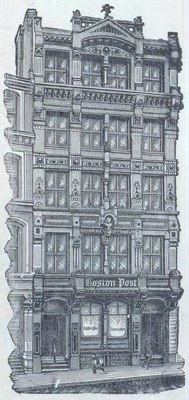
Boston Post Building The Boston Journal is both a morning and an evening paper. It
long
ago obtained an excellent reputation as a general newspaper, both for
the counting-room and the family circle. It has a very large sale
throughout Massachusetts, Maine and New Hampshire, and in consequence
of the peculiar character of its constituency has always been
especially strong in its New England intelligence. The Journal was
founded in 1833, appearing for the first time on February 5 of that
year as the Evening Mercantile Journal. On the beginning the
publication of a morning edition, it took its present name. The Journal
was the first newspaper in Boston to procure a Hoe press. it is now
equipped with the Hoe perfecting presses, and prints from stereotyped
plates. The Journal is Republican in politics. The present building was
occupied in September, 1860. In March, 1880, the interior was badly
injured by fire. Then it was practically rebuilt, many modern
conveniences being introduced. The Journal has now one of the most
convenient newspaper offices in the city. The retail price of the paper
was in the winter of 1883 reduced to two cents, and the circulation was
in consequence considerably increased. William W. Clapp is the present
conductor of the Journal.
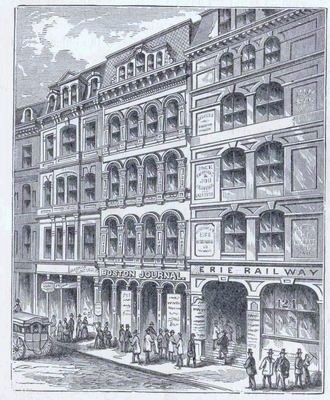
The Boston Journal Building. The Herald Building is on the west side of Washington Street,
nearly
opposite that of the Journal. The Herald is a morning and evening
paper, with a Sunday edition, and has an average daily circulation of
over 100,000 copies, which is second to that of but one newspaper in
America (the New York Sun). It has issued as many as 302,030 copies in
a single day, a feat which is extraordinary in the history of
journalism. The forms are stereotyped, since no other method would
enable it to print the requisite number of copies within the limited
available time. This paper was founded in 1846, as a one-cent daily, by
the name of the American Eagle; and two years later assumed its present
title, and took an independent position in politics, which it has
maintained ever since, The editorial staff includes 44 persons; and
there are 84 compositors, 30 men in the business department, and 11 in
the stereotyping foundry. Early in 1878 the Herald occupied the present
building which had been erected for it, with a façade in the
French Renaissance style, 100 feet high from the side-walk, massively
constructed and liberally equipped, with copious ornamentation in pure
marbles, sculptures, metal work, and precious woods. It is quite worth
while to look into the business office, on the ground-floor, and see
its sumptuous adornment of many-colored polished marbles, plate-glass,
and mahogany, and the busy scene which is there continually presented
to view. The Herald publishes a Sunday edition, in 16-page form, of
which great numbers are sold. John Holmes is the editor-in-chief of the
Herald, and is a member of the Herald Publishing Company, to whom the
paper was sold in 1888 by the former proprietors.
The Advertiser Building, on the east side of the street, was, before
the erection of the new Globe Building adjoining it, the tallest office
in “Newspaper Row.” It is a marble-front structure,
extending through to Devonshire Street; and from its location in the
bend of the street as well as its striking appearance architecturally,
it is one of the most conspicuous buildings in the quarter. The street
floor is occupied by the counting-room, a finely decorated and uniquely
furnished apartment; the extensive basement accommodates the
stereotyping, printing, mailing, and delivery rooms; and the upper
floors are devoted to the editorial rooms, editors’ library and
reception room, and the composition room. The building is provided with
all the modern improvements and appliances which are to be found in the
best equipped modern newspaper offices; and the entire Advertiser
establishment is lighted at night by the Edison electric light. The
Advertiser is the oldest daily paper in Boston, established in 1812. It
was edited for many years by Nathan Hale. It is an interesting fact
that the site of its former building on Court Street, from which it
removed to its present building in the spring of 1883, is that from
which James Franklin issued the first number of the New England
Courant, in 1721. The same spot was again occupied as a printing-office
in 1776, by the Independent Chronicle, to the rights of which the
Advertiser succeeded. The Advertiser is accounted one of the leading
morning journals of New England. In politics it is now Republican. The
Boston Evening Record, started Sept. 3, 1884, as a campaign paper,
became so manifestly popular that it was made a permanent enterprise.
It increased rapidly in circulation, reaching a daily issue of 35,000
in little more than a year. It is a large four-page paper, is sold for
one cent, and is published by the Advertiser. Its leading feature is
the prompt publication of the news in attractive shape, with pithy
comment. W. E. Barrett directs the business and editorial departments
of both papers.
The Boston Globe occupies the lofty freestone building, next door below
the new Advertiser building. The first number of the Globe was issued
from its present office March 4, 1872. It was a quarto sheet, published
every morning except Sunday, handsomely printed, and Edwin P. Whipple
was its literary critic. Though professedly independent in politics, it
advocated and maintained the cardinal doctrines of the Republican
party. Subsequently it changed hands, and was for several years
conducted more independently. In 1878 the Globe again changed its tone,
and also its form, becoming a four-page Democratic paper. It now
publishes morning and evening, and Sunday editions (the latter of
twelve or sixteen pages), competing with the Herald. The present
conductor of the Globe is Charles H. Taylor.
The Evening Traveller occupies a building at the corner of State and
Congress streets, — quarters in which it has been established
since 1854. The Daily Traveller was first issued on the first of April,
1845, as a two-cent evening paper, — the first in Boston to adopt
a price so low. The weekly American Traveller had then been issued more
than twenty years, having been first published in January, 1825. In its
day the American Traveller was the great paper for stage-coaches and
steamboats. When the daily was founded, it adopted a course quite
different from that of any other paper in Boston. It aimed to be a
moral and religious organ as well as a medium of news. The old
traditions are still retained to some extent in the Traveller, but it
long ago adopted the purveyance of news as its leading object. In this
particular its reputation is firmly established, the news department,
under a liberal management, being always prompt and full. The editorial
and composition rooms are on the third and fourth floors of the
building. The Traveller is owned and managed by Roland Worthington, for
some years collector of the port of Boston. A view of the Traveller
Building is given in the illustration of State Street, on page 70.
Within “Newspaper Row” or its immediate neighborhood are
the offices of the several exclusively Sunday papers, — the
Saturday Evening Gazette, conducted by Colonel Henry G. Parker, which
is largely devoted to society news; the Boston Courier, formerly one of
the leading dailies, now conducted by Joseph R. Travers, and edited by
Arlo Bates; the Boston Sunday Budget; and
the Boston Times. Here also are the offices of the Beacon, a literary
and society paper published Saturdays, the Commercial Bulletin, the
Republic, and other serial publications devoted to special interests.
Farther up Washington Street, nearly opposite the Globe Theatre, is the
office of The Boston Pilot, which is the headquarters of a vast
influence over the Roman Catholics of America. It is a weekly paper of
large size — the largest Catholic paper in America — and
has a circulation unequalled by that of any other Catholic paper in the
world. The Pilot is owned by Archbishop Williams and Mr. John Boyle
O’Reilly, and is ably edited by the latter, whose pen has done
distinguished service in other directions, and who has a well
established reputation as a graceful poet.
In connection with the newspapers, general and class journals, it may
be interesting to glance at the cosmopolitan character of the Puritan
City, and to note the widely divergent elements which go to make up the
Bostonian of today. According to the census of 1885, out of a total
population of 390,393, there were born in foreign countries 133,295. By
far the larger part of the foreigners are from Ireland, which has sent
67,745 of the present citizens of the New England metropolis. Canada
(British America) comes next, with 30,356. Great Britain has given us
nearly 13,650 in the following detachments: England 10,197; Scotland,
3,193; Wales, 254. It seems that the stream of emigration from the
British Isles, which Maverick and Winthrop started, has not yet ceased
to flow to the shores of Massachusetts Bay. Germany has now 8,810
representatives in Boston; Sweden and Norway have 2,533; Holland, 326;
Denmark, 225; and Russia and Poland, 1,854. The Latin nations have made
but slight contributions to this great Gothic migration, although 2,378
have come from sunny Italy, 1,039 from France and Switzerland, 1,122
from Portugal, and 274 from China.
The clubs located within this district are the Temple, the oldest in
the city, and the Paint and Clay, one of the youngest. The club-house
of the former is in West Street, situated in its own building, No. 35,
opposite Mason Street and near the rear or “carriage”
entrance to the Boston Theatre. This is a social club organized in
1829. The character of the Paint and Clay is well indicated by its
name. It is a club of professional men, largely artists. Its rooms are
on the upper floor of No. 419 Washington Street. It was established in
1880. Exhibitions of work of its artist members are made annually,
generally in the spring.
We end this chapter, as we began it, with a view in State Street. This
time our sketch shows the magnificent row of warehouses at the lower
end of State Street, known as State Street Block, which contains some
of the most substantially built and commodious stores in Boston. The
building, or rather the collection of buildings, covers an area 425
feet long on State and Central streets, and is of a uniform depth of
125 feet. The walls are laid in rough granite ashlar. The stores have
each five stories and a double attic above the street, and the height
of the buildings from the street to the crown of the roof is about 92
feet. The general appearance of this block of fifteen stores is of
extreme solidity. The excellence of construction was proved by fire but
a week after the great conflagration of November, 1872, when one of
these stores, filled with exceedingly combustible material, was wholly
destroyed without doing injury to the stores on either side.
Many other wharves in Boston besides Long Wharf are covered with solid
and capacious warehouses, though this State Street Block is the largest
and most elegant of all. The visitor in the city will find agreeable
occupation for many a leisure hour in wandering about the wharves,
where there is, under the revival of commerce in Boston, a perpetual
scene of activity. The most important wharves in Boston proper beside
Long Wharf are those in the immediate vicinity of State Street, —
especially Central, India, and T Wharves, where most of the large
steamers in the coasting trade arrive, and whence they depart. Atlantic
Avenue, which has become an important channel of communication between
the several wharves, passes directly across the fore-ground of our view
of State Street Block. This avenue was laid out in 1868, extended 1874.
It is a broad, well-paved street, which is almost entirely given up to
the heavy drays that transfer freight from wharf to wharf, or from
vessels to the business warehouses. Through its centre runs the Union
Freight railroad, which unites by a short and easy route the northern
and the southern railway lines. The line reaches front the Lowell
Railroad freight station, on Lowell Street, to the Old Colony, on
Kneeland Street. This company owns no rolling-stock whatever, and its
sole office is to transfer freight-cars from one line to another, or
from the railroads to the wharves. This is done chiefly or altogether
by night, and thus the regular traffic is not interfered with in the
least. By the use of this line it has been made possible to load
vessels at the large wharves directly from cars brought into the city
over railroads that have no deep-water connection in the city proper.
It is owned jointly by the Old Colony and Boston and Providence
Railroad Companies.

State Street Block. Before leaving this section of the city notice should be taken
of
the new system of sewerage. By this system the mouths of the numerous
common sewers which formerly opened into the ocean at different points
along the water front of the city are connected by intercepting sewers
which encircle the city, and join the new main sewer on the south side
of the city. This main sewer, which is 34 miles long, ends at the
Pumping Station at Old Harbor Point, on the seacoast in Dorchester,
about a mile from any dwelling. In flowing by gravitation to this
point, the sewage descends from 11 to 14 feet below the elevation of
low tide. To reach its final destination, about 2 ½ miles
further, it is raised by pumping about 35 feet and flows through a
tunnel under Dorchester Bay to Squantum, and thence through an open
flume to Moon Island, where it is stored in a reservoir, and let out
into the harbor twice a day at high water. The two principal evils of
the old system are thus practically corrected. These were: First, the
damming up of the common sewers by the tide, by which, for much of the
time, they were converted into stagnant cesspools; the air in them was
compressed, and to find outlets was driven into house-drains and other
openings. Second, the discharge of the sewage on the shores of the city
in the immediate vicinity of population, thereby causing nuisances at
many points. It was estimated that in 1869 there were 100 miles of
sewers in Boston, and in 1886 about 226 miles.
|













